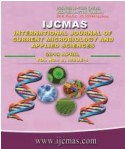


 National Academy of Agricultural Sciences (NAAS)
National Academy of Agricultural Sciences (NAAS)

|
PRINT ISSN : 2319-7692
Online ISSN : 2319-7706 Issues : 12 per year Publisher : Excellent Publishers Email : editorijcmas@gmail.com / submit@ijcmas.com Editor-in-chief: Dr.M.Prakash Index Copernicus ICV 2018: 95.39 NAAS RATING 2020: 5.38 |
Benign prostate hypertrophy (BPH) is a non- malignant condition characterized by proliferation of prostatic cells leading to an increase in prostate size, urethral obstruction, and lower urinary tract symptoms. For men, prostate hypertrophy with bladder outlet obstruction is reported to be the major predisposing factor for the development of asymptomatic bacteriuria. The Infectious Diseases Society of America (IDSA) established guidelines for the screening and treatment of asymptomatic bacteriuria (ASBU) in BPH, which recommends routine screening, and treatment of ASBU before transurethral resection of the prostate (TURP) and before other urological procedures, in which mucosal bleeding is anticipated. To study the distribution of asymptomatic bacteriuria in patients with Benign prostate hypertrophy (BPH) posted for transurethral resection of prostate (TURP), and to determine the bacterial profile of the pathogens causing ASBU and their antimicrobial susceptibility and resistance pattern. Urine samples were collected appropriately from 100 patients with BPH who were posted for TURP, and those who were not having symptoms of Urinary tract infection (UTI). The samples were cultured by standard semi-quantitative calibrated loop method. The isolated bacteria were identified by standard microbiological procedures. Antimicrobial susceptibility testing (AST) was performed according to the CLSI 2017 guidelines. Co morbid conditions were studied and the results were analyzed using SPSS software. ASBU was observed in 27% of the 100 patients in the study group with benign prostate hypertrophy. The bacterial profile as identified by urine culture in these patients, was Escherichia coli 13(48.7%), Klebsiella pneumoniae 4 (14.8%), Klebsiella oxytoca 4(14.8%), Pseudomonas aeruginosa 2(7.4%), Acinetobacter baumannii 2 (7.4%), Staphylococcus aureus 1 (3.7%) and Proteus mirabilis 1 (3.7%). The AST by Kirby Bauer disc diffusion test revealed that all the 13 isolates of Escherichia coli(100%) were sensitive to Cotrimoxazole,92.3% to Imipenem,84.6% each to Amikacin and Ampicillin whereas, Klebsiella species namely pneumoniae and oxytoca demonstrated a higher percentage of susceptibility only to the second line of antibiotics like Imipenem and Piperacillin tazobactam at 75% and 100 % respectively. Antimicrobial resistance testing demonstrated that 5 of the 13 E. coli isolates (35%) and 2 of the 4 K.pneumoniae were ESBL producers, of which one isolate of K. pneumoniae was KPC producer too. MBL production was observed in one each of A.boumanii and P.aeruginosa. Statistical analysis using chi square test showed that Diabetes mellitus as a co morbid condition was significantly associated with ASBU (P value 0.017%). Routine screening for asymptomatic bacteriuria by culture and AST profile in patients with BPH undergoing TURP is appropriate especially in patients with co morbid conditions like Diabetes mellitus. so that prophylactic AST guided antibiotic therapy should be initiated in these patients to prevent complications.
 |
 |
 |
 |
 |